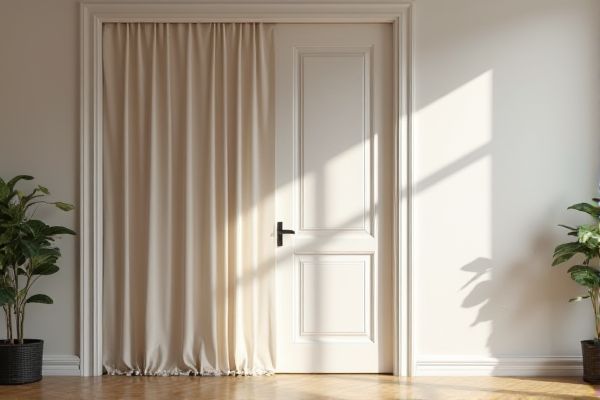
Closet curtains offer a flexible, space-saving solution that can add a soft aesthetic and are easier to install compared to traditional closet doors, which provide a more permanent and polished look with options like sliding, bi-fold, or hinged styles. Explore the full article to discover which option best suits your space, style, and functional needs.
Table of Comparison
| Feature | Closet Curtain | Closet Door |
|---|---|---|
| Installation | Easy, minimal tools required | Complex, requires hinges and precise fitting |
| Cost | Low, affordable materials | Higher, due to hardware and materials |
| Space Efficiency | Takes minimal space, no swing area | Requires clearance to open |
| Accessibility | Quick and full access | Partial access, depending on door type |
| Privacy & Aesthetics | Varied fabric options, softer look | Solid, structured appearance |
| Durability | Less durable, prone to wear | More durable, long-lasting |
| Maintenance | Easy to clean or replace fabric | Requires cleaning and occasional hardware upkeep |
Introduction to Closet Curtain vs Closet Door
Closet curtains offer a flexible and space-saving alternative to traditional closet doors, providing easy access and customizable fabric options for various decor styles. Closet doors, such as sliding, bi-fold, or hinged types, deliver a more structured and polished appearance while offering durability and enhanced privacy. Choosing between closet curtains and doors depends on factors like room layout, maintenance preferences, and desired aesthetic impact.
Space Efficiency: Curtains vs Doors
Closet curtains maximize space efficiency by eliminating the need for clearance required by swinging or sliding doors, making them ideal for tight or narrow areas. Doors, especially bifold or sliding types, may require additional room for operation but provide a more structured and durable barrier against dust and noise. Choosing curtains enhances accessibility and flexibility in small spaces, while doors offer better insulation and organized aesthetics.
Installation and Maintenance Comparison
Closet curtains require simple installation, often involving a tension rod or ceiling-mounted track, making them an easy DIY option with minimal tools, while closet doors typically need heavier hardware, precise measurements, and professional assistance for hinging or sliding mechanisms. Maintenance for curtains involves regular laundering or dusting to keep fabrics fresh and free of allergens, contrasting with closet doors that demand occasional cleaning of tracks, hinges, and surfaces to prevent sticking or damage. Your choice depends on whether you prefer the low-maintenance flexibility of curtains or the durable, structured appeal of closet doors.
Style and Decor Flexibility
Closet curtains offer greater style and decor flexibility by allowing easy customization with various fabrics, patterns, and colors to match any room aesthetic, while closet doors provide a more structured and polished look with materials like wood, glass, or mirrored panels. Curtains can be quickly changed or updated to reflect seasonal trends and personal taste, enhancing room ambiance without permanent alterations. Doors, although less adaptable, add architectural definition and can complement overall interior design themes such as modern, traditional, or minimalist styles.
Cost Comparison: Curtains vs Doors
Closet curtains typically cost between $20 and $100, making them a budget-friendly option compared to closet doors, which can range from $100 to over $500 depending on materials and installation. Curtains offer affordability and easy replacement, while doors may require professional installation, increasing overall expenses. Your choice depends on balancing upfront costs with long-term durability and aesthetic preferences.
Accessibility and Convenience
Closet curtains offer greater accessibility by allowing full-width opening without obstruction, making it easier to reach items quickly compared to traditional closet doors. Curtains can be drawn aside smoothly and require less space to operate, enhancing convenience in tight or compact rooms. Closet doors, particularly sliding or bi-fold types, may limit access to half or sections of the closet at a time, potentially hindering efficient use.
Privacy and Coverage
Closet curtains offer flexible coverage that can be easily drawn back or closed, providing variable privacy levels depending on the material used, while closet doors deliver consistent, solid coverage that ensures maximum privacy and concealment of belongings. Curtains may allow gaps or light to pass through, whereas doors create a complete barrier, enhancing security and preventing dust accumulation. Your choice between the two affects the balance between accessibility, privacy, and protection of your closet's contents.
Durability and Longevity
Closet doors, typically made from solid wood or metal, offer superior durability and longevity compared to fabric closet curtains that can wear out or fade over time. Doors provide a sturdy barrier against dust, moisture, and physical impact, preserving the contents inside your closet more effectively. Choosing closet doors ensures a long-lasting solution that maintains functionality and appearance with minimal maintenance.
Sound and Light Control
Closet doors provide superior sound insulation and block more light compared to closet curtains, creating a quieter and darker storage space. Curtains are typically made from fabric, allowing sound to pass through and light to filter, which can be less effective in maintaining privacy and minimizing noise. For enhanced soundproofing and light control, solid closet doors, especially those with airtight seals, are the preferred option.
Best Uses: When to Choose Curtains or Doors
Closet curtains are ideal for small spaces or irregular openings where flexibility and easy access are important, providing a soft, customizable look. Closet doors, such as sliding or bi-fold models, are best suited for larger closets, offering a clean, organized appearance with improved durability and noise reduction. Consider your room's size, style preferences, and how often you access your closet when deciding between your closet curtain or door.
 homyna.com
homyna.com